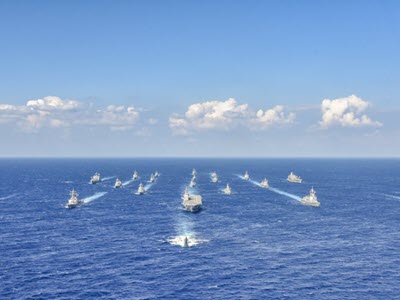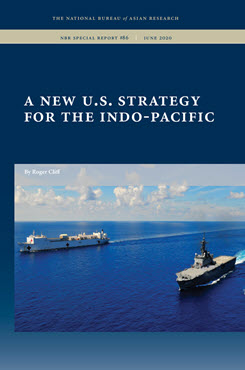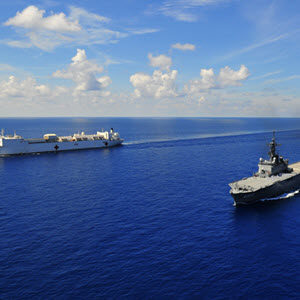Interview
U.S. Strategy at an Inflection Point
Challenges to U.S. Interests in the Indo-Pacific
The Indo-Pacific will pose major challenges for U.S. security over the coming years and decades. In an NBR Special Report published in June, Roger Cliff developed a comprehensive strategy for the United States to address the threats to U.S. interests through strengthening alliances and promoting democracy. Ian Smith interviewed Dr. Cliff for insight on some of the key findings of his report and what they mean for U.S. strategy in the Indo-Pacific moving forward.
You mention in the introduction to the report that the Indo-Pacific region is of “critical importance” to the United States. Can you expand on this? What makes the Indo-Pacific potentially more important for U.S. interests than other regions?
More than half of the world’s population resides in the Indo-Pacific, and the region generates a third of the world’s economic output. The United States has more trade with the Indo-Pacific than with any other region, and some of its most important allies are located there. As a result, the Indo-Pacific has been an important source of security and prosperity for the United States in recent decades.
That security and prosperity, however, is increasingly threatened. China has an economy that is already larger than that of the United States, spends more on its military than any country other than the United States, and has territorial disputes with many U.S. allies and security partners. China has also been covertly infiltrating the societies and political systems of numerous countries, including the United States itself. Meanwhile, North Korea has been developing nuclear weapons and intercontinental ballistic missiles capable of reaching the United States.
Major economic challenges and opportunities are arising in the Indo-Pacific as well. In January 2017 the United States withdrew from the Trans-Pacific Partnership, a free trade agreement involving seven Indo-Pacific countries and five countries from the Western Hemisphere that would have encompassed nearly 40% of the world’s economy. The eleven remaining countries, however, joined together to form an alternative arrangement. Meanwhile, China has been promoting a broader but shallower agreement called the Regional Comprehensive Economic Partnership, which will include fifteen Indo-Pacific countries but not the United States. Thus, the United States could find itself increasingly excluded from the world’s most economically dynamic region.
Within the Indo-Pacific, what do you see as the most important U.S. interests based on your assessment of current global threats? Which U.S. interests are most in jeopardy?
The most important U.S. foreign policy interest will always be protecting the American people and political system from external aggression. No nation in the region poses a plausible threat to actually invade the United States or its territories, but China and North Korea do possess missiles capable of reaching U.S. territory. Threats to the United States also come in nonphysical form. Cyberattacks from China, North Korea, or other actors could potentially cause severe damage to the U.S. economy or infrastructure. China has been covertly undermining and weakening democracy in the United States through its efforts to constrain academic and policy discussions about China and by taking control of Chinese-language media outlets, which are a principal source of information for many Chinese-Americans.
A second important U.S. interest in the Indo-Pacific is maintaining the security and strength of democratic allies. The challenges of the region are too great for any one country, even the United States, to manage on its own. Having allies is thus key to protecting and managing U.S. interests. This includes not just formal treaty allies like Japan and South Korea, but other democracies in the region as well, such as India, Indonesia, and Taiwan. Some democracies in the region face external military threats. For other regional countries, it is democracy itself that is at risk from ethnic nationalism, religious extremism, or political subversion. Thus, the United States has an interest not only in making the democratic countries of the region stronger, but also in strengthening democratic institutions within those countries.
In chapter 2, you note that China’s defense expenditure grew by more than 800% between 1993 and 2018. What sort of regional power shifts might we see as a result of China’s increased defense spending? What could the United States do to blunt Chinese capabilities?
The power shift has already occurred. In 1993, China was just one of several regional military powers in the Indo-Pacific. Today, it is the dominant power in the region other than the United States. China’s annual defense expenditure is now roughly equal to that of all other Indo-Pacific countries combined. Although defense spending does not necessarily translate into actual military power, it is an indicator of the level of effort China is putting into developing and maintaining its military capabilities. If the United States does not remain politically and militarily engaged in the Indo-Pacific, China will eventually dominate the region.
There is not much the United States can do to blunt Chinese capabilities. The United States should certainly work with its allies and the other democracies of the world to restrict China’s access to military and dual-use technologies, but that will only slow—not prevent—the growth of Chinese military capabilities.
Rather than try to prevent China’s rise, the United States should seek to counterbalance it. This process is already underway. After many years of fielding capabilities optimized for fighting insurgents or low-tech regional adversaries like Iraq and North Korea, the U.S. Defense Department has finally started to focus on developing capabilities specifically designed to counter China. At the same time, the United States should also seek to strengthen the other democracies of the Indo-Pacific. In recent years, the U.S. government has been pressuring its allies to increase the amount they pay for the cost of U.S. forces stationed in their territory. But rather than trying to get them to subsidize U.S. military capabilities, the United States should instead be encouraging its allies to increase their own capabilities and finding ways to cooperate more closely with them. Collectively, the United States and its allies will be much stronger than the United States could ever be by itself.
In your chapter on potential major events, you find that interstate war would have the greatest impact on U.S. interests. In what areas is the risk for war highest, and how can U.S. policy serve to de-escalate latent future conflicts?
Although interstate conflict has been, and will likely remain, rare in the Indo-Pacific, there are a number of potential flashpoints in the region. Indeed, there is one ongoing conflict in the Kashmir region. Both India and Pakistan claim Kashmir as their territory and have fought for control of it off and on since they achieved independence in 1947. Although the conflict has been of low intensity since the 1999 Kargil War, the dispute always has the potential to flare up again. Given that both sides possess nuclear weapons, any escalation of the conflict would be worrisome.
Recently, a border dispute between China and India also resulted in deadly violence. A brief war between the two countries in 1962 resulted in more than nine thousand dead or wounded, but the conflict had been largely dormant since then. In June of this year, however, a violent confrontation between Indian and Chinese soldiers occurred that resulted in the deaths of twenty Indian soldiers and an unknown number of Chinese casualties. The dispute between China and India involves territories of less importance to both countries than the India-Pakistan dispute and, therefore, seems less likely to escalate to a major war. But any conflict between two rising nuclear powers is a source of concern.
Given Beijing’s recent actions on its border with India, it is possible that China’s territorial disputes in the South or East China Sea could escalate to lethal levels as well. The Korean Peninsula is also an ongoing source of worry. The movement a couple years ago toward a possible peace agreement appears to have ended, and North Korea has been acting more belligerently recently. Although a North Korean attempt at a full-scale invasion of South Korea seems unlikely, lesser acts of aggression—along the lines of the North’s sinking of a South Korean naval vessel and deadly shelling of a South Korean island in 2010—are possible.
The potential conflict that worries me the most right now, though, is over Taiwan. In January, voters re-elected a president and majority of legislators from the party that advocates eventual independence for Taiwan, and Beijing’s recent actions toward Hong Kong have probably eliminated any possibility that the people of Taiwan would ever willingly accept Beijing’s “one country, two systems” unification offer. The question is whether Chinese leaders realize this and, if so, what their response will be. The United States should make clear to Beijing that it would come to Taiwan’s defense in any circumstance other than an overt declaration of independence by Taipei.
In chapter 3, you identify North Korea as one of six regional countries with “the greatest potential to have a major impact on U.S. interests.” Will Pyongyang’s recent destruction of its Kaesong liaison building and remilitarization of the Demilitarized Zone (DMZ) change Washington’s strategy toward the peninsula?
It is hard to say whether Pyongyang’s recent destruction of its Kaesong liaison building and remilitarization of the DMZ will change Washington’s current strategy, but clearly a change of strategy is needed. A quarter century of efforts to convince North Korea to change its behavior have failed. Unfortunately, there is little evidence to suggest that the North Korean regime is on the verge of collapse. Although the Kim regime is unquestionably abhorrent, bringing about regime change is not a realistic policy goal. The United States should instead focus on reducing the danger North Korea poses to other countries. North Korea threatens other countries in a variety of ways, but the greatest danger comes from its possession of nuclear weapons. Thus, the U.S. priority should be to get North Korea to give up its nuclear weapons.
The principal purpose of North Korea’s nuclear weapons and missile programs has been to ensure regime survival. To convince Pyongyang to dismantle its nuclear weapons and facilities, therefore, Washington must assure the Kim regime that it will be allowed to remain in power. Doing so will require positive incentives for North Korea to dismantle its nuclear weapons, in the form of economic aid, combined with strong disincentives against keeping them, in the form of economic sanctions.
Given that most of North Korea’s trade goes through China, and China is North Korea’s primary security guarantor, Chinese cooperation will be needed for this approach to be effective. Beijing’s overriding goal on the Korean Peninsula is maintaining stability, which includes North Korea’s continued existence as an independent state. Thus, to persuade Beijing to pressure Pyongyang to give up its nuclear weapons, the United States will need to convince China’s leadership that it does not seek regime change. This would likely require some sort of formal treaty or communiqué between the three parties. There is no guarantee that this approach will succeed, but, in view of the dangers that North Korea’s nuclear weapons pose, Washington must continue to seek new ways to convince Pyongyang to relinquish them.
Has the Covid-19 pandemic strengthened or weakened U.S. resolve to play a key role in the region? Have other countries taken advantage of circumstances brought on by the pandemic, and if so, how do you think the United States will respond?
I do not think that the Covid-19 pandemic has weakened U.S. resolve to play a key role in the region. The question is not one of resolve, but of developing a strategy for implementing that resolve. Even before the pandemic, it was not clear what the U.S. strategy toward the region was.
Now we see China behaving in a way that suggests that its leaders believe that any consequences for actions that violate international norms will be minimal. Whether this is in response to a perceived opportunity created by the pandemic is unclear. What is clear is that if the United States fails to respond to these actions, they will likely continue and become worse. The other democracies of the region are looking to the United States to provide leadership. If it does, it will find that much of the region supports U.S. goals and interests. If it does not, then by the time a decision to act is made it might be too late and the United States will be on its own.
Roger Cliff conducts research on international relations in the Indo-Pacific. He has worked for the Center for Naval Analyses, Atlantic Council, Project 2049 Institute, RAND Corporation, and Office of the Secretary of Defense. His NBR Special Report “A New U.S. Strategy for the Indo-Pacific” was published in June.
This interview was conducted by Ian Smith, an Editorial Assistant at NBR.
RELATED PUBLICATION
A New U.S. Strategy for the Indo-Pacific





 The Future of U.S. Strategy in the Indo-Pacific
The Future of U.S. Strategy in the Indo-Pacific